
The next menu point in Author Central (link) is the Sales Info. Below that, you’ll find
- NPD Book Scan
- Sales Rank
- Author Rank
Now, before I explain in detail what that means and how seriously you should take it, I want to say something about the emotions that might come up looking at that data.
And it’s not necessarily good.
Because sales rank and author rank are markers you might confuse with success. And if they are unpleasant, you might get frustrated.
I want to suggest that you ignore these ranks. Or use them for entertainment. And most of all, that you can look at this graphs and simply smile. Because the biggest success is – especially if you are a first time author – that you got a book up available for sale.
Got that?
Good.
Now, NPD Book Scan only tracks print sales in the US, and it is SLOW. But it has one nifty feature and that is a map of where your books sold. Of course, that’s practically useless. But it’s fun to look at.
Sales Rank gives you data on each of your books, and shows you how well it performs compared to all other books on Amazon COM. You’ll see a spike for every sale (or borrow, if your book is in Kindle Unlimited), and then a gradual curve down again. It also doesn’t update quickly.
Author Rank is a little more fun. It’s calculated from your book sales, against all other authors on Amazon, but at least here you can drill down a bit into genre. My personal best was #1,594 in Fantasy.
Does that mean anything?
Not really.
First of all, Author Central is store based, unlike your sales dashboard through KDP. Right now, we’re looking at Amazon COM, and it ignores any sales in other stores such as UK, DE or Canada. Or India. So you’re only getting part of the picture anyway.
Here’s where you get to choose.
You can start getting desperate about the competition, or about the lack of sales, or about your dropping rank – or you can basically ignore it and work on your definition of success.
That means you can look at this once in a while, have fun with the sales and rank spikes, take a gander at where your print copies landed, laugh a little, and just get back to writing your next book.
I know what I prefer.
You see, getting frustrated and obsessing about sales and rank and all that data will hurt you in many ways, but most of all it’ll do this:
It will hurt your writing. It will hurt your creativity. It will make writing the next book harder.
And nothing sells your current book or books better than the next release.
Using Author Central for Personal Growth
Yes, that’s totally possible. Here’s how.
First, I would like you to take another look at that author rank. Go there. Look at it. Look at how many authors are doing better than you on Amazon COM.
Second, be aware of your feelings. Allow yourself to sense them. Don’t judge, just let them be.
And if they are negative (anger, disappointment, frustration, sadness, envy…), watch what’s coming up.
Are you judging yourself?
Blaming yourself?
Getting angry at other authors?
This is awesome tapping material. This is, in fact, what’s holding you back.
Third, use EFT tapping to release those beliefs, rants and feelings. Free yourself so you can be more creative, have more fun, and enjoy writing your books even more.
(And if you want to learn more about how to do this, shoot me an email or write a comment.)
*image source F. Möbius
PS: My monthly newsletter contains a full tapping round to go with my blog posts. Sign up through the form on the upper right hand corner, and receive that tapping round plus occasional special offers.
PPS: I can help you overcome mindset blocks and emotions like resistance, fear, frustration or sadness. EFT is the fastest way I know to shift limiting beliefs, old thought habits and other kinds of blocks. Click HERE and send me an email. Together, we’ll figure out how I can support you best.









